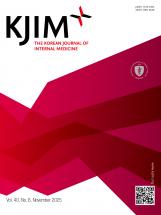|
Original Article / Brief Communication
Selecting coronavirus disease 2019 patients with negligible risk of progression: early experience from non-hospital isolation facility in Korea
Pyoeng Gyun Choe, Eun Kyo Kang, Sun Young Lee, Boram Oh, Dahae Im, Hyo Yeon Lee, Hyemin Jung, Chang Kyung Kang, Min Sun Kim, Wan Beom Park, Eun Hwa Choi, BeLong Cho, Myoung-don Oh, Nam Joong Kim
Korean J Intern Med. 2020;35(4):765-770. Published online May 29, 2020
Background/Aims: As the novel coronavirus (coronavirus disease 2019 [COVID-19]) outbreak progresses rapidly, staying home is recommended for suspected patients; however, the safety of this recommendation is uncertain. In Korea, non-hospital facilities called “living and treatment centers (LTCs)” ..
|
|
|
Original Article / Brief Communication
A cluster of tertiary transmissions of 2019 novel coronavirus (SARS-CoV-2) in the community from infectors with common cold symptoms
Nam Joong Kim, Pyoeng Gyun Choe, Sang-Joon Park, Jaegyun Lim, Wang Jun Lee, Chang Kyung Kang, Wan Beom Park, Moon-Woo Seong, Myoung-don Oh
Korean J Intern Med. 2020;35(4):758-764. Published online June 11, 2020
Background/Aims: As the global impact of the novel coronavirus disease 2019 (COVID-19) has been severe, many countries have intensified containment activities to eliminate virus transmission, through early detection and isolation strategies. To establish a proper quarantine strategy, it is essential..
|
|
|
Infectious diseases / Review
Middle East respiratory syndrome: what we learned from the 2015 outbreak in the Republic of Korea
Myoung-don Oh, Wan Beom Park, Sang-Won Park, Pyoeng Gyun Choe, Ji Hwan Bang, Kyoung-Ho Song, Eu Suk Kim, Hong Bin Kim, Nam Joong Kim
Korean J Intern Med. 2018;33(2):233-246. Published online February 27, 2018
Middle East Respiratory Syndrome coronavirus (MERS-CoV) was first isolated from a patient with severe pneumonia in 2012. The 2015 Korea outbreak of MERSCoV involved 186 cases, including 38 fatalities. A total of 83% of transmission events were due to five superspreaders, and 44% of the 186 MERS case..
|
|
|
Infectious diseases / Original Article
In vitro antiviral activity of ribavirin against severe fever with thrombocytopenia syndrome virus
Myung Jin Lee, Kye-Hyung Kim, Jongyoun Yi, Su Jin Choi, Pyoeng Gyun Choe, Wan Beom Park, Nam Joong Kim, Myoung-don Oh
Korean J Intern Med. 2017;32(4):731-737. Published online November 30, 2016
Background/Aims: Severe fever with thrombocytopenia syndrome (SFTS) is an emerging infectious disease caused by severe fever with thrombocytopenia syndrome virus (SFTSV), a novel bunyavirus. As yet, there is no effective antiviral therapy for SFTS. Ribavirin is a broad-spectrum antiviral agent, whic..
|
|
|
















